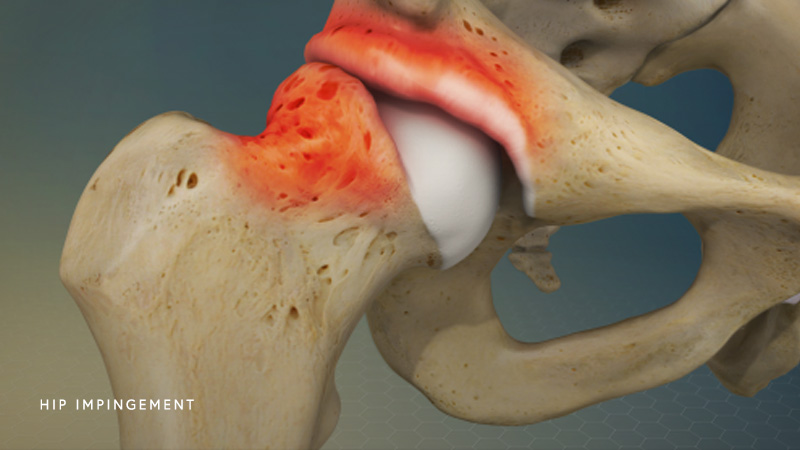Hip Impingement
What is hip impingement?
Hip impingement (Femoroacetabular Impingement (FAI)) is a common cause of hip and groin pain and a complex structural problem that is commonly found in young, active patients. It affects adolescents, adults and athletes of any age and is often only recognized when overuse of the hip joint causes pain. Early signs may be pain, limping and hip stiffness. Early diagnosis and intervention can prevent joint damage.

The hip is a ball and socket joint. The ball is the head of the thigh bone (the femur), and the socket is a depression in the hip bone called the acetabulum. The labrum is a ring of strong fibrocartilage that rims the edges of the socket to deepen it and seal the joint for stability and full range of motion.
Hip impingement is caused by hip bone deformities due to abnormal bone development on both the acetabulum and the head of the femur. The deformities are caused by genetics and become noticeable in response to recreational and professional athletics. Athletes with this underlying condition may have no symptoms until their bones are mature around age 15 and they participate in sports that cause groin pain. Importantly, many people with hip bone deformities may never have problems or have no symptoms until they take up a sport or overuse the joint.
The misaligned bones create abnormal hip movements that generate friction and pinch and tear the soft tissue in the labrum and the cartilage surrounding the bones. This pinching is called impingement. The damaged labrum impairs joint function, destabilizes the joint and leads to instability and hip joint degeneration. Hip impingement contributes to the progression of early hip osteoarthritis.
Some people with hip impingement lead active lives and never have symptoms. Others may develop symptoms with repetitive use such as an athlete who stresses the joint with extreme ranges of motion. When identified early mild and moderate cases can be treated nonsurgically.
Symptoms include but are not limited to:
- Motion-related hip pain
- Chronic, deep or aching groin pain with prolonged sitting or after walking.
- Occasional sharp pain during or after activity
- A locking, clicking or catching sensation in the joint
- Low back pain
- Pain in the buttocks, side of the hip or in the back of the pelvis
- Difficulty walking uphill
- Difficulty putting on socks and shoes
- Symptoms may be misread as tendinitis, a hernia or lumbar disc compression
Your hip specialist at the Center for Orthopaedic Specialists (COS) will review your medical history including any injuries, your activities and what induces symptoms, and conduct a thorough physical examination including testing range of motion, strength and gait analysis. Your COS specialist will conduct the hip impingement test.
The hip impingent test: The patient lies on their back with legs straight. The doctor raises the leg on the side that is experiencing pain pulling the knee toward the chest. Supporting the ankle and knee, the doctor lifts and rotates the foot and gently pushes the bent leg across the body. If the patient feels a pinching/ pain in the hip, it indicates hip impingement.
Imaging studies including x-rays and an MRI will show boney abnormalities and signs of soft tissue damage. The surgeon may recommend a diagnostic injection of a local anesthetic into the hip joint under image guidance to see if that numbs the pain which can be definitive for hip impingement. Early identification and intervention are critical to preventing damage to the joint labrum and bones.
Treatment depends on the severity of the impingement and the damage it is causing. Mild and moderate cases may improve with nonsurgical treatment.
Generally, nonsurgical management includes rest, activity modification, over the counter pain medication, physical therapy and therapeutic injections for symptom relief. The goal is to relieve symptoms and prevent joint damage. However, athletes treated nonsurgically have a low rate of return to sport and are often functionally limited in their performance.
When nonsurgical treatment fails to relieve pain and imaging studies reveal labrum tears and damage to the cartilage at the ends of the bones, hip preservation surgery may be recommended. The type of surgery may be minimally invasive arthroscopic surgery, or open surgery. The goal of hip preserving surgery is to preserve the hip joint, treat, protect and maintain the labrum, prevent arthritis and avoid or delay the need for hip replacement surgery.
Hip preservation surgery is very effective at relieving symptoms and preserving joint function. Surgical treatment offers high rates of return to sport and functional performance. Recovery after hip preservation surgery can take 4-6 months.
The fellowship trained and board certified orthopaedic surgeons at the Center for Orthopaedic Specialists have offices in Mission Hills, West Hills, Westlake Village and Tarzana California for your convenience.
We offer sports medicine and arthroscopic and reconstructive surgery of the shoulder, hand, arm, elbow, knee, hip, and ankle and spine, and fractures and trauma services for children and adults. Contact us to schedule a consultation. We also offer virtual consults.




 / 50 Reviews
/ 50 Reviews